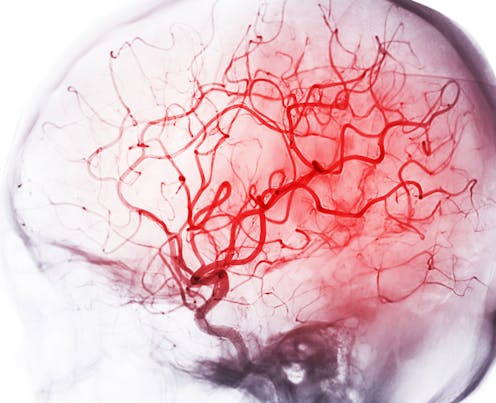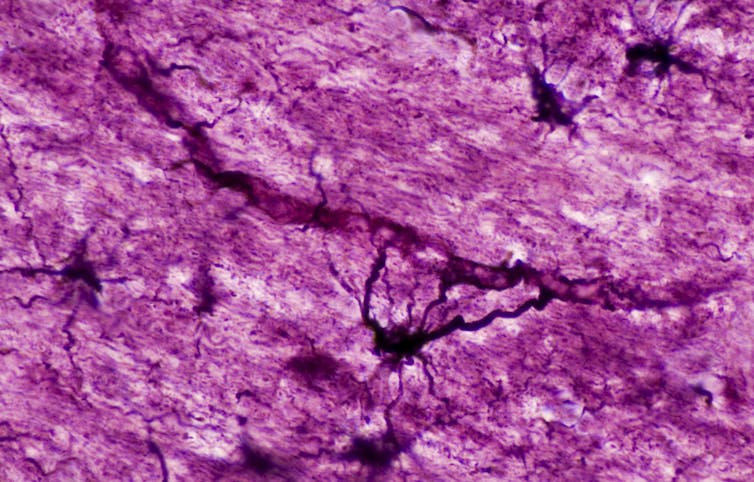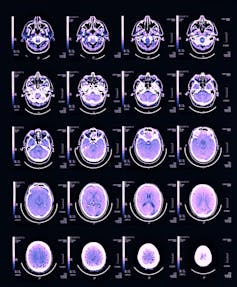
Neuroscientists have long assumed that neurons are greedy, hungry units that demand more energy when they become more active, and the circulatory system complies by providing as much blood as they require to fuel their activity. Indeed, as neuronal activity increases in response to a task, blood flow to that part of the brain increases even more than its rate of energy use, leading to a surplus. This increase is the basis of common functional imaging technology that generates colored maps of brain activity.
Scientists used to interpret this apparent mismatch in blood flow and energy demand as evidence that there is no shortage of blood supply to the brain. The idea of a nonlimited supply was based on the observation that only about 40% of the oxygen delivered to each part of the brain is used – and this percentage actually drops as parts of the brain become more active. It seemed to make evolutionary sense: The brain would have evolved this faster-than-needed increase in blood flow as a safety feature that guarantees sufficient oxygen delivery at all times.
But does blood distribution in the brain actually support a demand-based system? As a neuroscientist myself, I had previously examined a number of other assumptions about the most basic facts about brains and found that they didn’t pan out. To name a few: Human brains don’t have 100 billion neurons, though they do have the most cortical neurons of any species; the degree of folding of the cerebral cortex does not indicate how many neurons are present; and it’s not larger animals that live longer, but those with more neurons in their cortex.
I believe that figuring out what determines blood supply to the brain is essential to understanding how brains work in health and disease. It’s like how cities need to figure out whether the current electrical grid will be enough to support a future population increase. Brains, like cities, only work if they have enough energy supplied.
Resources as highways or rivers
But how could I test whether blood flow to the brain is truly demand-based? My freezers were stocked with preserved, dead brains. How do you study energy use in a brain that is not using energy anymore?
Luckily, the brain leaves behind evidence of its energy use through the pattern of the vessels that distribute blood throughout it. I figured I could look at the density of capillaries – the thin, one-cell-wide vessels that transfer gases, glucose and metabolites between brain and blood. These capillary networks would be preserved in the brains in my freezers.
A demand-based brain should be comparable to a road system. If arteries and veins are the major highways that carry goods to the town of specific parts of the brain, capillaries are akin to the neighborhood streets that actually deliver goods to their final users: individual neurons and the cells that work with them. Streets and highways are built on demand, and a road map shows what a demand-based system looks like: Roads are often concentrated in parts of the country where there are more people – the energy-guzzling units of society.
In contrast, a supply-limited brain should look like the river beds of a country, which couldn’t care less about where people are located. Water will flow where it can, and cities just have to adjust and make do with what they can get. Chances are, cities will form in the vicinity of the main arteries – but absent major, purposeful remodeling, their growth and activities are limited by how much water is available.

Would I find that capillaries are concentrated in parts of the brain with more neurons and supposedly require more energy, like streets and highways built in a demand-based manner? Or would I find that they are more like creeks and streams that permeate the land where they can, oblivious to where the most people are, in a supply-driven manner?
What I found was clear evidence for the latter. For both mice and rats, capillary density makes up a meager 2% to 4% of brain volume, regardless of how many neurons or synapses are present. Blood flows in the brain like water down rivers: where it can, not where it is needed.
If blood flows regardless of need, this implies that the brain actually uses blood as it is supplied. We found that the tiny variations in capillary density across different parts of dead rat brains matched perfectly with the rates of blood flow and energy use in the same parts of other living rat brains that researchers measured 15 years prior.
Resolving blood flow and energy demand
Could the specific density of capillaries in each part of the brain be so limiting that it dictates how much energy that part uses? And would that apply to the brain as a whole?
I partnered with my colleague Doug Rothman to answer these questions. Together, we discovered that not only do both human and rat brains do what they can with what blood they get and typically work at about 85% capacity, but overall brain activity is indeed dictated by capillary density, all else being equal.
The reason why only 40% of the oxygen supplied to the brain actually gets used is because this is the maximum amount that can be exchanged as blood flows by – like workers trying to pick up items on an assembly line going too fast. Local arteries can deliver more blood to neurons if they start using slightly more oxygen, but this comes at the cost of diverting blood away from other parts of the brain. Since gas exchange was already near full capacity to begin with, the fraction of oxygen extraction seems to even drop with a slight increase in delivery.
From afar, energy use in the brain may look demand-based – but it really is supply-limited.
Blood supply influences brain activity
So why does any of this matter?
Our findings offer a possible explanation for why the brain can’t truly multitask – only quickly alternate between focuses. Because blood flow to the entire brain is tightly regulated and remains essentially constant throughout the day as you alternate between activities, our research suggests that any part of the brain that experiences an increase in activity – because you start doing math or playing a song, for example – can only get slightly more blood flow at the expense of diverting blood flow from other parts of the brain. Thus, the inability to do two things at the same time might have its origins in blood flow to the brain being supply-limited, not demand-based.

Our findings also offer insight into aging. If neurons must make do with what energy they can get from a mostly constant blood supply, then the parts of the brain with the highest densities of neurons will be the first to be affected when there is a shortage – just like the largest cities feel the pain of a drought before smaller ones.
In the cortex, the parts with the highest neuron densities are the hippocampus and entorhinal cortex. These areas are involved in short-term memory and the first to suffer in aging. More research is needed to test whether the parts of the brain most vulnerable to aging and disease are the ones with the greatest number of neurons packed together and competing for a limited blood supply.
If it’s true that capillaries, like neurons, last a lifetime in humans as they do in lab mice, then they may play a bigger role in brain health than expected. To make sure your brain neurons remain healthy in old age, taking care of the capillaries that keep them supplied with blood may be a good bet. The good news is that there are two proven ways to do this: a healthy diet and exercise, which are never too late to begin.
Suzana Herculano-Houzel does not work for, consult, own shares in or receive funding from any company or organisation that would benefit from this article, and has disclosed no relevant affiliations beyond their academic appointment.
This article was originally published on The Conversation. Read the original article.







